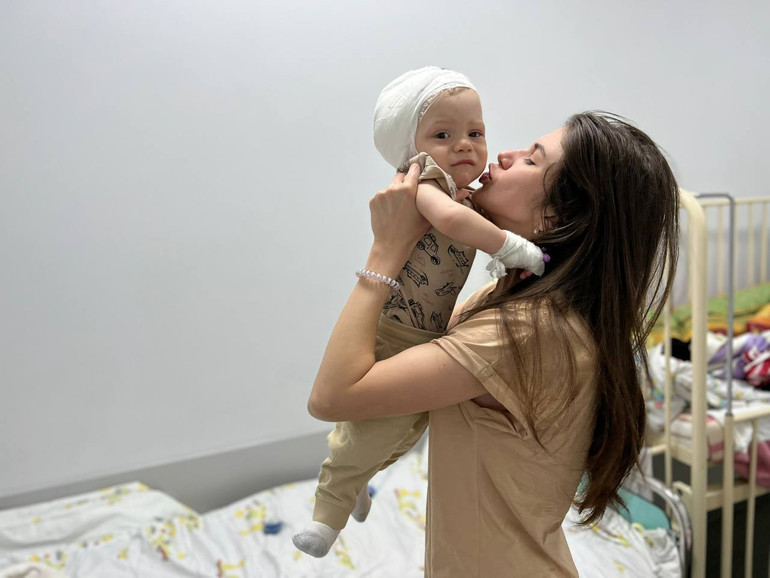What is Cochlear implantation and who is needed

Up to 4 children out of 1000 newborns may have hearing impairments. Usually the causes of congenital deafness are the pathology of the snail of the inner ear of the baby.
At risk – premature children with small weight and toddlers with heredity. For example, Diana from Nikolaev, who was born at the 26th week of pregnancy weighing only 730 grams. Her parents learned that her daughter had a full deafness when the baby was a year old. Diana did not talk or respond to the sounds of the outside world. Now she is 3 years old, and after cochlear implantation (operations during which a device with a thin electrode is used in the inner ear) in the Lviv Ohmatdita she hears this world.
Alexander from Lviv region was born with innate deaf. When the boy was half a year, the mother noted that the baby did not respond to loud sounds. Doctors confirmed the boy’s deafness on both ears. Hearing aids did not produce any results. After cochlear implantation in Lviv Okhmatdita and rehabilitation, a 2-year-old baby heard the first sounds in his life.
What it is for surgery, when it is worth carrying out, what are the shows and contraindications, as well as what myths continue to exist on cochlear implants, « UP. Life » asked the head of the clinic of pediatric otolaryngology of Lviv Hospital « Okhmatdit » Fyodor Yurochko.
– What is cochlear implantation?
– Cochlear implantation is an operation during which a child is used in the inner ear with a thin electrode. It connects with the auditory nerve and transmits sound vibrations to the brain, which processes this information.
We all want an instant result, but it takes our time. On the second day after the first cochlear implant operations, senior doctors said: « Wow, as apparently, the child hears, look, reacts, turns his head« . In fact, it was a random reaction of the child, but was perceived as a lightning reaction to sound.
Because the child will be able to hear sounds only after the implant connects the outer part (the language processor), which converts the sound to a digital signal and processes it. This usually happens 3-4 weeks after surgery, when the wounds have already healed. The outer and inner parts are interconnected by a magnet, without screws or darts, so it is absolutely painless for the patient.
Cochlear implantation is an operation during which a child in the inner ear is consumed with a thin electrode
Ohmatdit Center for Pediatric Medicine
– When the child starts to hear and understand the sounds?
– From the moment of connection of the outer part begins prolonged active rehabilitation of the patient. It includes the work of language teachers, speech therapists, surdologists, hearing physicians, as well as regular parents with a child. The main goal is to maximize speech and hearing development in new conditions.
After connecting the implant, parents actually receive a baby – it feels as if their baby had just been born and heard the sound for the first time.
Some parents mistakenly believe that the implant works like a TV: turned on – and immediately sound. In fact, the development of hearing and language depends on the intensity of classes with the child, its cognitive opportunities and brain plasticity.
The child’s brain has an incredible ability to adapt, but that does not mean that the process will go away on its own. Even if the child has an average level of intellectual development, the active work of parents can produce fantastic results. Conversely, even a very capable child can not develop hearing and speech without proper support.
– Which hearing impaired patients are shown cochlear implantation?
– The operation is shown to children with deep hearing impairment or full deafness on both ears, if the hearing aids do not give effective hearing and speech development. It is extremely important not to waste a lot of auditory experience so that there is no significant lag in development from peers.
– What are the examinations of children?
– An accurate diagnosis is performed before implantation. One of the key stages is the screening of the hearing of the newborn. According to the standards of the Ukrainian health care system, every maternity hospital must be equipped with a newborn hearing.
If the baby is screening, it is very likely that the hearing is normal. However, there are cases where the hearing worsens several months after birth, so parents should monitor the baby’s hearing behavior.
Signs of what the child hears: she responds to sounds, shudders to loud sounds, clips, turns his head towards the sound source.
But if the baby has not been scrubbed, it does not mean that it does not hear. Physiologically, after birth, the baby at the eardrum may be mucus, which will work over time. In this case, a re -examination is recommended for three and six months. Experts carry out diagnostics using electrophysiological methods that are independent of cooperation of the child.
If in the age of six years of age is confirmed, the next step is the selection and use of hearing aids. The child should wear them constantly, and specialists watch the development of speech and hearing.
It is possible to draw conclusions after 3-4 months of wearing hearing aids (usually at the age of 10-11 months). If hearing and speech do not develop, the child becomes a candidate for cochlear implantation. Of course, some of the cases that come to us are children who have passed screening after birth. But there are those who are given in older age (2-3 years), when parents begin to notice that the child does not respond to sounds or does not speak. In such cases, the diagnosis is delayed.

The development of hearing and language in a child who survived cochlear implantation depends on the intensity of classes
Ohmatdit Center for Pediatric Medicine
– At what age do we talk about a late diagnosis?
– The younger the child, the higher the plasticity of her brain. That is, the ability of the brain to adapt to variable conditions of the environment, to process different stimuli – visual, auditory, tactile. With age, plasticity decreases.
The ideal option is to make a diagnosis at the age of six months and to perform surgery at the age of one. World practice shows that this is the optimal time. But for another 3 years you can achieve good results in hearing and speech development. Such children can study in ordinary kindergarten, school and do not need sign language.
We had cases where the operation was performed at the age of 4 years. But this child constantly used the hearing aid, and her brain received some auditory stimulation, that is, he received and processed sounds.
In this case, cochlear implantation was justified and in fact became its last chance to develop hearing and speech. And this child began to develop a good development of hearing and language.
However, after 6-7 years, implantation in congenital deafness no longer has the desired effect.
– If the deafness is acquired, is there a deadline for surgery in this case?
– As for the acquired deafness, such cases in children are rare, more often they occur in adults. It can occur due to specific viral infections or by bacterial meningitis.
Up to 10% of children after bacterial meningitis may lose hearing within 1.5-2 months. Inflammation of the brain protective membranes can switch to the snail of the inner ear and « block » the channels (they are first filled with granulation, which is subsequently converted to bone). In this case, it will not be possible to enter the electrode.

Before implanting the child is conducted accurate diagnosis
Ohmatdit Center for Pediatric Medicine
– What are the risks and contraindications to cochlear implantation?
– There are cases where surgery is simply ineffective. For example, in children with congenital malformations of the ear, if they do not have an auditory nerve. In this case, implantation will not make sense, because there will be no conductivity of electrical impulses through the auditory nerve.
There are also general medical contraindications – a serious neurological condition, such as severe epilepsy. In such cases, the decision is made individually and the operation may either postpone or not recommend.
Surgery can also be postponed due to an active viral infection or if there is a risk of residual manifestations of otitis.
No operation is completely safe. Possible risks include bleeding, hematomas, balance disorders (since the inner ear is a vestibular apparatus), temporary or constant taste disorders due to nerve damage, infectious complications such as otitis or meningitis. All these risks are assessed by the doctor before surgery.
– What are the implants and what is the difference between them?
– Concerning the choice of cochlear implants – fortunately, now the state has been buying them for budget for the second year.
There are three major manufacturers in the world that offer different models depending on the patient’s needs. Each manufacturer claims that its system is the best. Here you can draw an analogy with cars: as between BMW, Mercedes and Audi, each manufacturer has its own strengths, and the choice depends on the specific needs of the patient.
Cochlear implants cost as a good car – the average cost of one device can reach 25 thousand euros. Each of the three main producers of cochlear implants is working on the development of their technologies: they improve electrodes, their length, materials, there are many parameters. But there is no fundamental difference between implants.
But our people are always looking for alternatives: if they give BMW, someone will say what Audi wants. And even if it is free, they will still choose.
Parents often look for « better destiny », think that somewhere is the best doctor, the best clinic. But the main thing is not the place of implantation, but the fact of the operation. Waiting, hope that the problem will disappear by itself – this is a great risk. For example, some delay implantation a year, expecting the baby to suddenly start talking. But such a strategy is dangerous, and you can lose precious time for hearing development.

One of the contraindications for cochlear implantation is a severe neurological condition, such as epilepsy with severe course
Ohmatdit Center for Pediatric Medicine
– Do these devices get out of time?
– The inner part of the implant is designed for decades and remains stable. But the outer part is recommended to be updated every five years, although it can work much longer. This can also be compared to a car that has a guarantee from the manufacturer. But this does not mean that after the end of the car will suddenly stop riding.
– How to care for implant?
– The internal part does not require special care – it just works. But the outer part requires regular cleaning, storage in a dry place and charging.
Moisture is an enemy of electronics, so you should not neglect drying for long -term operation of such a delicate device.
If you follow all the recommendations, the implant can serve for many years without need to be replaced.
– Are there restrictions for active sports?
-Yes, with cochlear implants you can not engage in traumatic sports, such as boxing, judo, rugby.
Also, if the baby falls with a bicycle without a helmet and will hit the part of the head where the implant is located, there may be complications.
With regard to water sports, there are special protective covers for the outside of the device that allow you to go swimming. You can also simply remove the outer part when swimming. The internal implant has no physical contact with the external, there are no wires or plugs between them, but only a magnetic connection. This can be compared to two magnets, between which lies a piece of paper.

Cochlear implants are purchased by the state for budgetary funds
Ohmatdit Center for Pediatric Medicine
– Have you encountered myths what parents use as a counter -argument for cochlear implantation?
– Recently, there are much smaller cases because there is a lot of information available through the Internet, as well as other patients who have already undergone implantation and can share experience.
But previously there were real myths! For example, not only parents but also doctors convinced that implantation was dangerous. I personally heard, as they said, « Why do you implantation? The baby will stick out of the head like antennas!« . Now, fortunately, misinformation has become much less.
Victoria Andreeva, UP








